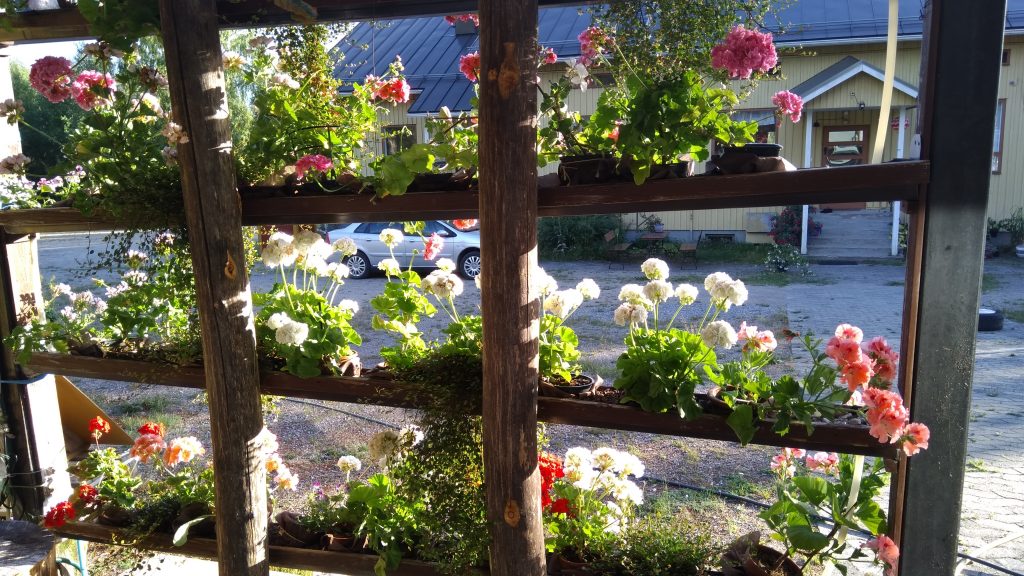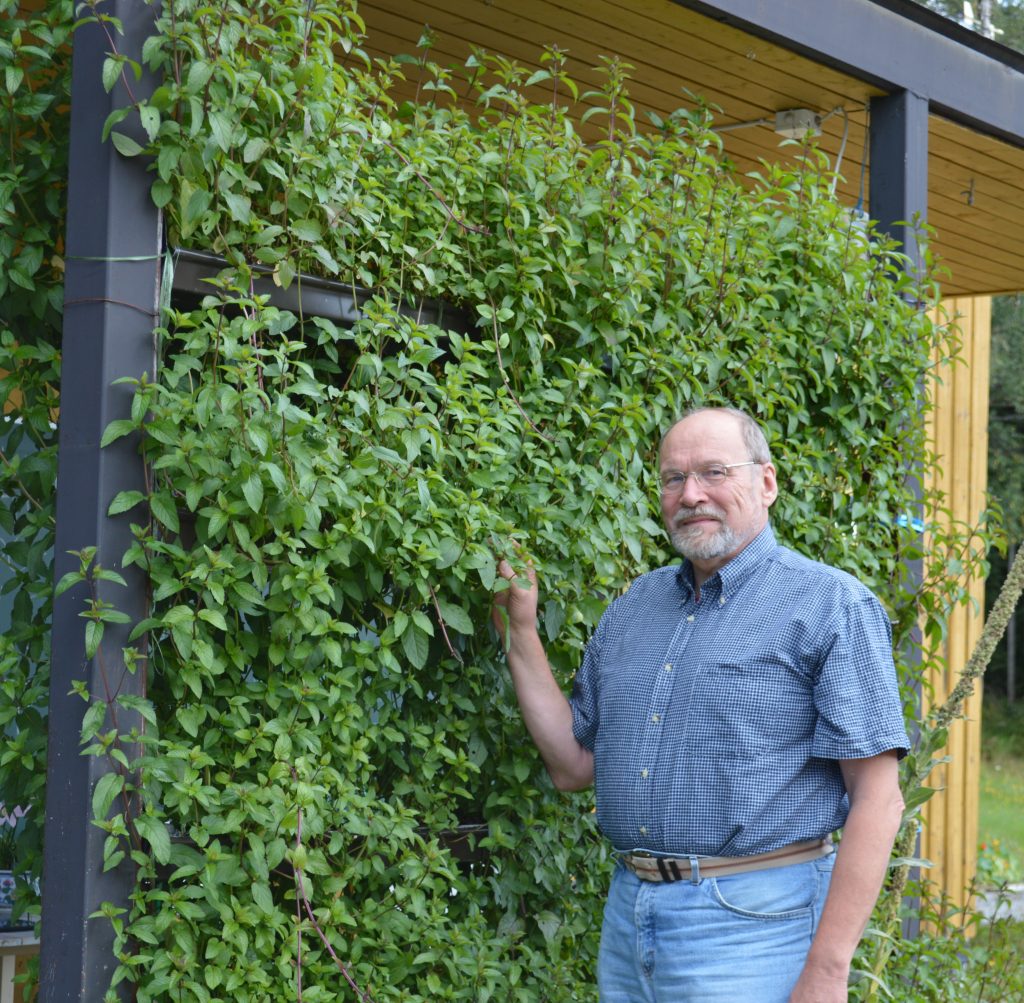13
Kari Kotiranta
Anmerkung der Herausgeber: Tiedetila ist eine „Wissenschaftsfarm“ in Finnland, die mit einem Computermuseum verbunden ist. Sie wird von Kari und Tuula Kotiranta betrieben. Kari berichtet im Folgenden über das von ihm entwickelte Aquakultur-System:

Das Aquakultur-System besteht aus einer Plattform für Pflanzen in Form eines Gitters. Dafür sind vier Rinnen zwischen tragende Pfosten unter einem Vorbau gesetzt. Die Rinnen sind so eingestellt, dass das Wasser von einer Rinne zur anderen abfließen kann. Das Wasser wird durch eine Tauchpumpe, die in einem 50-Liter-Behälter unter den Dachrinnen des Vorbaus platziert ist, zur obersten Rinne befördert.
Das Ziel ist ein konstanter, langsamer Wasserfluss zu den Wurzeln der Pflanzen. Die notwendigen Nährstoffe werden mit dem Wasser transportiert. Der Wasserdurchfluss muss entsprechend den Umgebungsbedingungen reguliert werden. Daher kann der Fluss nicht kontinuierlich sein. Um den Wasserfluss zu regulieren, wird ein Kontrollsystem benötigt. Die Steuerung erfolgt über einen Arduino-Mikrocontroller. Der Mikrocontroller steuert die Relais anhand der Messwerte. Das derzeit in Tiedetila befindliche System wird manuell gesteuert – sowohl die Dauer des Pumpens als auch das Intervall zwischen den Pumpen. Arduino liest den Status der Steuerpotentiometer und teilt dem System die Pumpzeit und das Pumpintervall mit. Daher funktioniert das System gut, wenn das Wetter stabil ist. Mit anderen Worten, es sollte keine großen Wetterumschwünge geben.
Die Regelpotentiometer können durch einen Lichtsensor ersetzt werden, der die Lichtmenge anzeigt, die in die Pflanzen einfällt – ob die Sonne scheint und wie hell. Bei sonnigem Wetter brauchen die Pflanzen eine höhere Zirkulation von Wasser und Nährstoffen. Auch eine automatische Dünger-Zufuhr kann in das System eingebaut werden. Pro gepumpter Wassermenge wird eine bestimmte Düngermenge zugeführt. Diese Funktion wurde in Tiedetila nicht aktiviert, da das System während der Regenzeit durcheinander gerät. Recyceltes Wasser verdünnt sich durch Regen unkontrolliert. Als Nährmedium verwendet das System LECA-Partikel (Blähton), das pflanzenneutral ist, alle Nährstoffe werden mit dem Wasser zu den Pflanzen gebracht.

In verschiedenen Jahren wurde versucht unterschiedliche Pflanzen anzubauen: Es gab Pfefferminze, Geranien, Erbsen und verschiedene Blumen. Als Ergebnis kann festgestellt werden, dass alle getesteten Pflanzen relativ gut gewachsen sind – im beschriebenen Aquakultur-System.
Erforderliche Komponenten
– Mikrocontroller, Arduino Uno – Potentiometer zum Pumpen und Intervalleinstellung – 1-3 Relais, je nachdem, welche Funktionen für das System erforderlich sind. Relais steuern Zapfsäulen und Pumpen. – Kleine Wasserpumpe, Tauchpumpe 12V. Die Pumpe ist unten in einen Wasserbehälter eingetaucht. – Netzteile für 12V Wasserpumpe und 5V Arduino unter. Wir haben in Tiedetila ein Solarpanel, einen Regler und eine Batterie 12V verwendet. – Ausreichende Dachrinnen, um das System zu implementieren.
Editor’s note: Tiedetila is a “science farm” in Finland associated with a computer museum. It is run by Kari and Tuula Kotiranta. Kari reports below on the aquaculture system he has developed:

The aquaculture system consists of a platform for plants in the form of a grid. For this, four gutters are placed between supporting posts under a porch. The gutters are set so that the water can flow from one gutter to the other. The water is conveyed to the top gutter by a submersible pump placed in a 50-litre tank under the gutters of the porch.
The goal is a constant, slow flow of water to the roots of the plants. The necessary nutrients are transported with the water. The water flow must be regulated according to the environmental conditions. Therefore, the flow cannot be continuous. To regulate the water flow, a control system is needed. The control is done by an Arduino microcontroller. The microcontroller controls the relays based on the measured values. The system currently in Tiedetila is controlled manually – both the duration of pumping and the interval between pumps. Arduino reads the status of the control potentiometers and tells the system the pumping time and interval. Therefore, the system works well when the weather is stable. In other words, there should not be big changes in the weather.
The control potentiometers can be replaced by a light sensor that indicates the amount of light entering the plants – whether the sun is shining and how bright. In sunny weather, the plants need a higher circulation of water and nutrients. An automatic fertiliser feed can also be built into the system. A certain amount of fertiliser is added per amount of water pumped. This feature has not been activated in Tiedetila because the system goes haywire during the rainy season. Recycled water dilutes uncontrollably due to rain. As a nutrient medium, the system uses LECA particles (expanded clay), which is plant-neutral; all nutrients are brought to the plants with the water.

In different years, attempts were made to grow different plants: There was peppermint, geraniums, peas and various flowers. As a result, it can be stated that all tested plants grew relatively well – in the described aquaculture system.
Required components
– Microcontroller, Arduino Uno – Potentiometer for pumping and interval adjustment – 1-3 relays, depending on which functions are required for the system. Relays control dispensers and pumps. – Small water pump, submersible pump 12V. The pump is submerged in a water tank at the bottom. – Power supplies for 12V water pump and 5V Arduino under. We used a solar panel, regulator and battery 12V in Tiedetila. – Sufficient gutters to implement the system.
